Spatiotemporal Changes and the Prediction of Drought Characteristics in a Major Grain-Producing Area of China
Abstract
:1. Introduction
2. Dataset and Methods
2.1. Study Area
2.2. Data Sources
2.3. Drought Trends and Periodicity
2.4. Drought Event Identification
2.5. Prediction Model
2.6. Cropland Exposure to Drought
3. Results
3.1. Drought Dynamic Characteristics
3.1.1. Spatiotemporal Variation of SPEI
3.1.2. Drought Periodicity
3.1.3. Drought Event Characteristics
3.2. Drought Prediction
3.2.1. Selection of Preferable Model
3.2.2. Temporal and Spatial Variation
3.2.3. Drought Event Characteristics
3.3. Cropland Exposure Characteristics
4. Discussion
4.1. Trends and Periodic Features of Drought Changes
4.2. Drought Regional Differentiation Characteristics and Adaptation Recommendations
5. Conclusions
- (1)
- Based on Sen’s slope and MMK approaches, we demonstrated a predominant trend toward increasing wetness in Henan Province over the 59-year study period. However, we observed contradictory trends, i.e., a transition from dry to wet during 1961–1999, followed by a transition from wet to dry during 2000–2019. Wavelet analysis showed periodic variation in drought evolution with cycles of 6 and 26 years.
- (2)
- The spatial distribution of drought event characteristics indicated that southern Henan Province had a higher drought frequency; these droughts tended to have shorter duration and relatively low severity during 1961–2019. We also found that the drought frequency, higher drought duration and peak would greatly increase to 1.28–3.40-fold compared with that of 2000–2019 using the BO-LSTM model.
- (3)
- The average cropland exposure to drought of Henan Province during 1961–1999 was 33,302.81 km2, while it decreased to 20,907.96 km2 in the first two decades of the 21st century, and could rise again to 33,745.12 km2 in the near future. On the city scale, 94.44% of cities would face increasing cropland exposure challenges.
Author Contributions
Funding
Data Availability Statement
Acknowledgments
Conflicts of Interest
References
- Yao, N.; Li, Y.; Lei, T.; Peng, L. Drought evolution, severity and trends in mainland China over 1961–2013. Sci. Total Environ. 2018, 616, 73–89. [Google Scholar] [CrossRef]
- Douris, J.; Kim, G. WMO Atlas of Mortality and Economic Losses from Weather, Climate and Water Extremes (1970–2019) (WMO-No. 1267). In WMO Statement on the State of the Global Climate; WMO: Geneva, Switzerland, 2021; Volume 1267. [Google Scholar]
- Ciais, P.; Reichstein, M.; Viovy, N.; Granier, A.; Ogée, J.; Allard, V.; Aubinet, M.; Buchman, N.; Bernhofer, C.; Carrara, A. Europe-wide reduction in primary productivity caused by the heat and drought in 2003. Nature 2005, 437, 529–533. [Google Scholar] [CrossRef] [PubMed]
- Masih, I.; Maskey, S.; Mussá, F.E.F.; Trambauer, P. A review of droughts on the African continent: A geospatial and long-term perspective. Hydrol. Earth Syst. Sci. 2014, 18, 3635–3649. [Google Scholar] [CrossRef]
- Hua, L.; Ma, Z.; Zhong, L. A Comparative Analysis of Primary and Extreme Characteristics of Dry or Wet Status between Asia and North America. Adv. Atmos. Sci. 2011, 28, 352–362. [Google Scholar] [CrossRef]
- Stagge, J.H.; Kingston, D.G.; Tallaksen, L.M.; Hannah, D.M. Observed drought indices show increasing divergence across Europe. Sci. Rep. 2017, 7, 14045. [Google Scholar] [CrossRef] [PubMed]
- Zeng, P.; Sun, F.; Liu, Y.; Wang, Y.; Li, G.; Che, Y. Mapping future droughts under global warming across China: A combined multi-timescale meteorological drought index and SOM-Kmeans approach. Weather Clim. Extrem. 2021, 31, 100304. [Google Scholar] [CrossRef]
- Naumann, G.; Alfieri, L.; Wyser, K.; Mentaschi, L.; Betts, R.; Carrao, H.; Spinoni, J.; Feyen, L. Global changes in drought conditions under different levels of warming. Geophys. Res. Lett. 2018, 45, 3285–3296. [Google Scholar] [CrossRef]
- Araujo, D.S.A.; Marra, F.; Merow, C.; Nikolopoulos, E. Today’s 100 year droughts in Australia may become the norm by the end of the century. Environ. Res. Lett. 2022, 17, 044034. [Google Scholar] [CrossRef]
- Jenkins, K.; Warren, R. Quantifying the impact of climate change on drought regimes using the Standardised Precipitation Index. Theor. Appl. Climatol. 2015, 120, 41–54. [Google Scholar] [CrossRef]
- Spinoni, J.; Barbosa, P.; Bucchignani, E.; Cassano, J.; Cavazos, T.; Christensen, J.H.; Christensen, O.B.; Coppola, E.; Evans, J.; Geyer, B.; et al. Future Global Meteorological Drought Hot Spots: A Study Based on CORDEX Data. J. Clim. 2020, 33, 3635–3661. [Google Scholar] [CrossRef]
- Hari, V.; Rakovec, O.; Markonis, Y.; Hanel, M.; Kumar, R. Increased Future Occurrences of the Exceptional 2018–2019 Central European Drought under Global Warming. Sci. Rep. 2020, 10, 12207. [Google Scholar] [CrossRef]
- Haile, G.G.; Tang, Q.; Hosseini-Moghari, S.; Liu, X.; Gebremicael, T.G.; Leng, G.; Kebede, A.; Xu, X.; Yun, X. Projected Impacts of Climate Change on Drought Patterns over East Africa. Earth’s Future 2020, 8, e2020EF001502. [Google Scholar] [CrossRef]
- West, H.; Quinn, N.; Horswell, M. Remote sensing for drought monitoring & impact assessment: Progress, past challenges and future opportunities. Remote Sens. Environ. 2019, 232, 111291. [Google Scholar] [CrossRef]
- Başağaoğlu, H.; Sharma, C.; Chakraborty, D.; Yoosefdoost, I.; Bertetti, F.P. Heuristic data-inspired scheme to characterize meteorological and groundwater droughts in a semi-arid karstic region under a warming climate. J. Hydrol. Reg. Stud. 2023, 48, 101481. [Google Scholar] [CrossRef]
- McKee, T.B.; Doesken, N.J.; Kleist, J. The relationship of drought frequency and duration to time scales. In Proceedings of the Eighth Conference on Applied Climatology, Anaheim, CA, USA, 17–22 January 1993; Volume 17, pp. 179–183. [Google Scholar]
- Trenberth, K.E.; Dai, A.; van der Schrier, G.; Jones, P.D.; Barichivich, J.; Briffa, K.R.; Sheffield, J. Global warming and changes in drought. Nat. Clim. Chang. 2014, 4, 17–22. [Google Scholar] [CrossRef]
- Beguería, S.; Vicente-Serrano, S.M.; Reig, F.; Latorre, B. Standardized precipitation evapotranspiration index (SPEI) revisited: Parameter fitting, evapotranspiration models, tools, datasets and drought monitoring. Int. J. Climatol. 2014, 34, 3001–3023. [Google Scholar] [CrossRef]
- Sheffield, J.; Wood, E.F.; Roderick, M.L. Little change in global drought over the past 60 years. Nature 2012, 491, 435–438. [Google Scholar] [CrossRef] [PubMed]
- Hui-Mean, F.; Yusop, Z.; Yusof, F. Drought analysis and water resource availability using standardised precipitation evapotranspiration index. Atmos. Res. 2018, 201, 102–115. [Google Scholar] [CrossRef]
- Vicente-Serrano, S.M.; Beguería, S.; López-Moreno, J.I. A multiscalar drought index sensitive to global warming: The standardized precipitation evapotranspiration index. J. Clim. 2010, 23, 1696–1718. [Google Scholar] [CrossRef]
- Vicente-Serrano, S.M.; Beguería, S.; Lorenzo-Lacruz, J.; Camarero, J.J.; López-Moreno, J.I.; Azorin-Molina, C.; Revuelto, J.; Morán-Tejeda, E.; Sanchez-Lorenzo, A. Performance of Drought Indices for Ecological, Agricultural, and Hydrological Applications. Earth Interact. 2012, 16, 1–27. [Google Scholar] [CrossRef]
- Ionita, M.; Nagavciuc, V. Changes in drought features at the European level over the last 120 years. Nat. Hazards Earth Syst. Sci. 2021, 21, 1685–1701. [Google Scholar] [CrossRef]
- Wang, H.; Cao, L.; Li, X.; Feng, R.; Zheng, P. Differences in drought evolution as portrayed for China using various evapotranspiration models and drought indices. Int. J. Climatol. 2022, 42, 9404–9429. [Google Scholar] [CrossRef]
- Ullah, I.; Ma, X.; Yin, J.; Asfaw, T.G.; Azam, K.; Syed, S.; Liu, M.; Arshad, M.; Shahzaman, M. Evaluating the meteorological drought characteristics over Pakistan using in situ observations and reanalysis products. Int. J. Climatol. 2021, 41, 4437–4459. [Google Scholar] [CrossRef]
- Sharafi, S.; Ghaleni, M.M. Spatial assessment of drought features over different climates and seasons across Iran. Theor. Appl. Climatol. 2021, 147, 941–957. [Google Scholar] [CrossRef]
- Shi, L.; Feng, P.; Wang, B.; Liu, D.; Yu, Q. Quantifying future drought change and associated uncertainty in southeastern Australia with multiple potential evapotranspiration models. J. Hydrol. 2020, 590, 125394. [Google Scholar] [CrossRef]
- Thornthwaite, C.W. An Approach toward a Rational Classification of Climate. Geogr. Rev. 1948, 38, 55–94. [Google Scholar] [CrossRef]
- Allen, R.G.; Pereira, L.S.; Raes, D.; Smith, M. Crop Evapotranspiration-Guidelines for Computing Crop Water Requirements; FAO Irrigation and Drainage Paper 56; FAO: Rome, Italy, 1998; pp. 1–289. [Google Scholar]
- Um, M.J.; Kim, Y.; Park, D.; Jung, K.; Wang, Z.; Kim, M.M.; Shin, H. Impacts of potential evapotranspiration on drought phenomena in different regions and climate zones. Sci. Total Environ. 2020, 703, 135590. [Google Scholar] [CrossRef]
- Zhou, S.; Wang, Y.; Li, Z.; Chang, J.; Guo, A.; Zhou, K. Characterizing spatio-temporal patterns of multi-scalar drought risk in mainland China. Ecol. Indic. 2021, 131, 108189. [Google Scholar] [CrossRef]
- Hao, Z.; Singh, V.P.; Xia, Y. Seasonal Drought Prediction: Advances, Challenges, and Future Prospects. Rev. Geophys. 2018, 56, 108–141. [Google Scholar] [CrossRef]
- Deo, R.C.; Şahin, M. Application of the Artificial Neural Network model for prediction of monthly Standardized Precipitation and Evapotranspiration Index using hydrometeorological parameters and climate indices in eastern Australia. Atmosph. Res. 2015, 161, 65–81. [Google Scholar] [CrossRef]
- Ortiz-Garcia, E.; Salcedo-Sanz, S.; Casanova-Mateo, C. Accurate precipitation prediction with support vector classifiers: A study including novel predictive variables and observational data. Atmos. Res. 2014, 139, 128–136. [Google Scholar] [CrossRef]
- Xiong, B.; Li, R.; Ren, D.; Liu, H.; Xu, T.; Huang, Y. Prediction of flooding in the downstream of the Three Gorges Reservoir based on a back propagation neural network optimized using the AdaBoost algorithm. Nat. Hazards 2021, 107, 1559–1575. [Google Scholar] [CrossRef]
- Xiao, C.; Chen, N.; Hu, C.; Wang, K.; Gong, J.; Chen, Z. Short and mid-term sea surface temperature prediction using time-series satellite data and LSTM-AdaBoost combination approach. Remote Sens. Environ. 2019, 233, 111358. [Google Scholar] [CrossRef]
- Xu, Y.; Hu, C.; Wu, Q.; Jian, S.; Li, Z.; Chen, Y.; Zhang, G.; Zhang, Z.; Wang, S. Research on particle swarm optimization in LSTM neural networks for rainfall-runoff simulation. J. Hydrol. 2022, 608, 127553. [Google Scholar] [CrossRef]
- Wu, J.; Chen, X.Y.; Zhang, H.; Xiong, L.D.; Lei, H.; Deng, S.H. Hyperparameter Optimization for Machine Learning Models Based on Bayesian Optimizationb. J. Electron. Sci. Technol. 2019, 17, 26–40. [Google Scholar] [CrossRef]
- Di, Y.; Gao, M.; Feng, F.; Li, Q.; Zhang, H. A New Framework for Winter Wheat Yield Prediction Integrating Deep Learning and Bayesian Optimization. Agronomy 2022, 12, 3194. [Google Scholar] [CrossRef]
- Zou, S.; Zhang, L.; Huang, X.; Osei, F.B.; Ou, G. Early Ecological Security Warning of Cultivated Lands Using RF-MLP Integration Model: A Case Study on China’s Main Grain-Producing Areas. Ecol. Indic. 2022, 141, 109059. [Google Scholar] [CrossRef]
- Wang, Z.; Zhang, E.; Chen, G. Spatiotemporal Variation and Influencing Factors of Grain Yield in Major Grain-Producing Counties: A Comparative Study of Two Provinces from China. Land 2023, 12, 1810. [Google Scholar] [CrossRef]
- Zhu, Y.; Pan, P.; Kuang, X.; Yang, N.; Liu, Y. Changing Characteristics and Causes Analysis of Drought Disaster in Henan Province. Chin. J. Agrometeorol. 2011, 32, 311–316. [Google Scholar] [CrossRef]
- Shi, B.; Zhu, X.; Hu, Y.; Yang, Y. Drought characteristics of Henan province in 1961-2013 based on Standardized Precipitation Evapotranspiration Index. J. Geogr. Sci. 2017, 27, 311–325. [Google Scholar] [CrossRef]
- Xu, L.; Chen, N.; Yang, C.; Zhang, C.; Yu, H. A parametric multivariate drought index for drought monitoring and assessment under climate change. Agric. For. Meteorol. 2021, 310, 108657. [Google Scholar] [CrossRef]
- Zhao, H.Y.; Gao, G.; Yan, X.D.; Zhang, Q. Risk assessment of agricultural drought using the CERES-Wheat model: A case study of Henan Plain, China. Clim. Res. 2011, 50, 247–256. [Google Scholar] [CrossRef]
- Easterling, D.R.; Wehner, M.F. Is the climate warming or cooling? Geophys. Res. Lett. 2009, 36, L08706. [Google Scholar] [CrossRef]
- Lean, J.L. Observation-based detection and attribution of 21st century climate change. Wiley Interdiscip. Rev. Clim. Chang. 2018, 9, e511. [Google Scholar] [CrossRef]
- Asong, Z.E.; Wheater, H.S.; Bonsal, B.; Razavi, S.; Kurkute, S. Historical drought patterns over Canada and their teleconnections with large-scale climate signals. Hydrol. Earth Syst. Sci. 2018, 22, 3105–3124. [Google Scholar] [CrossRef]
- Yao, N.; Li, L.; Feng, P.Y.; Feng, H.; Liu, D.L.; Liu, Y.; Jiang, K.T.; Hu, X.T.; Li, Y. Projections of drought characteristics in China based on a standardized precipitation and evapotranspiration index and multiple GCMs. Sci. Total Environ. 2020, 704, 135245. [Google Scholar] [CrossRef] [PubMed]
- Khan, N.; Shahid, S.; Ismail, T.B.; Wang, X.J. Spatial distribution of unidirectional trends in temperature and temperature extremes in Pakistan. Theor. Appl. Climatol. 2019, 136, 899–913. [Google Scholar] [CrossRef]
- Cao, S.; He, Y.; Zhang, L.; Chen, Y.; Yang, W. Spatiotemporal characteristics of drought and its impact on vegetation in the vegetation region of Northwest China. Ecol. Indic. 2021, 133, 108420. [Google Scholar] [CrossRef]
- Ayantobo, O.O.; Li, Y.; Song, S.; Yao, N. Spatial comparability of drought characteristics and related return periods in mainland China over 1961–2013. J. Hydrol. 2017, 550, 549–567. [Google Scholar] [CrossRef]
- Yevjevich, V.M. An Objective Approach to Definitions and Investigations of Continental Hydrologic Droughts; Hydrology Papers; Colorado State University: Fort Collins, CO, USA, 1967. [Google Scholar]
- Moriconi, R.; Deisenroth, M.P.; Sesh Kumar, K.S. High-dimensional Bayesian optimization using low-dimensional feature spaces. Mach. Learn. 2020, 109, 1925–1943. [Google Scholar] [CrossRef]
- Wang, A.; Tao, H.; Ding, G.; Zhang, B.; Huang, J.; Wu, Q. Global cropland exposure to extreme compound drought heatwave events under future climate change. Weather Clim. Extrem. 2023, 40, 100559. [Google Scholar] [CrossRef]
- Li, X.; Ju, H.; Liu, Q.; Li, Y.; Qin, X. Analysis of drought characters based on the SPEI-PM index in Huang-Huai-Hai Plain. Acta Ecol. Sin. 2017, 37, 2054–2066. [Google Scholar] [CrossRef]
- Lu, J.; Rong, G.; Feng, Y.; Zuo, T. Drought Characteristics and Its Correlation with Circulation Index in Henan Province Based on SPEI Index. Chin. Rural Water Hydropower 2022, 17–24. [Google Scholar] [CrossRef]
- Wang, Z.; Li, J.; Lai, C.; Zeng, Z.; Zhong, R.; Chen, X.; Zhou, X.; Wang, M. Does drought in China show a significant decreasing trend from 1961 to 2009? Sci. Total Environ. 2017, 579, 314–324. [Google Scholar] [CrossRef] [PubMed]
- Feng, W.; Lu, H.; Yao, T.; Yu, Q. Drought characteristics and its elevation dependence in the Qinghai-Tibet plateau during the last half-century. Sci. Rep. 2020, 10, 14323. [Google Scholar] [CrossRef]
- Guan, X.; Huang, J.; Guo, R. Changes in aridity in response to the global warming hiatus. J. Meteorol. Res. 2017, 31, 117–125. [Google Scholar] [CrossRef]
- Du, Q.; Zhang, M.; Wang, S.; Che, C.; Ma, R.; Ma, Z. Changes in air temperature over China in response to the recent global warming hiatus. J. Geogr. Sci. 2019, 29, 496–516. [Google Scholar] [CrossRef]
- Li, Z.; Zhu, L.; Zhang, Y.; He, P. Spatial and temporal variations of drought in Henan Province over a 55-year period based on standardized precipitation index. Jiangsu Agric. Sci. 2018, 46, 237–242. [Google Scholar] [CrossRef]
- Tao, J.; Qiao, W.; Li, H.; Qu, X.; Gan, R. Spatial and temporal evolution characteristics and causes of drought and flood in the Henan section of the Yellow River. Nat. Hazards 2022, 113, 997–1016. [Google Scholar] [CrossRef]
- Wang, F.; Wang, Z.; Yang, H.; Di, D.; Zhao, Y.; Liang, Q. Utilizing GRACE-based groundwater drought index for drought characterization and teleconnection factors analysis in the North China Plain. J. Hydrol. 2020, 585, 124849. [Google Scholar] [CrossRef]
- Xu, W.; Wang, W.; Ma, J.; Xu, D. ENSO events during 1951–2007 and their characteristic indices. J. Nat. Dis. 2009, 18, 18–24. [Google Scholar] [CrossRef]
- Qian, C.; Yu, J.Y.; Chen, G. Decadal summer drought frequency in China: The increasing influence of the Atlantic Multi-decadal Oscillation. Environ. Res. Lett. 2014, 9, 124004. [Google Scholar] [CrossRef]
- Dong, L.; Fu, C.; Liu, J.; Zhang, P. Combined effects of solar activity and El Niño on hydrologic patterns in the Yoshino River Basin, Japan. Water Resour. Manag. 2018, 32, 2421–2435. [Google Scholar] [CrossRef]
- Zhou, L.; Wu, J.; Mo, X.; Zhou, H.; Diao, C.; Wang, Q.; Chen, Y.; Zhang, F. Quantitative and detailed spatiotemporal patterns of drought in China during 2001–2013. Sci. Total Environ. 2017, 589, 136–145. [Google Scholar] [CrossRef]
- Yuan, B.; Wang, S.; Guo, L. Drought Vulnerability Assessment of Winter Wheat Using an Improved Entropy-Comprehensive Fuzzy Evaluation Method: A Case Study of Henan Province in China. Atmosphere 2023, 14, 779. [Google Scholar] [CrossRef]
- Shang, D.; Zhang, Z.; Yue, Y.; Hu, C.; Wang, Q. Drought characteristics analysis of Henan Province based on standardized precipitation index in recent 45 years. Agric. Res. Arid Areas 2021, 39, 162–170. [Google Scholar] [CrossRef]
- Ma, X.; Zhao, J. Analysis on Characteristics of Extreme Temperature Change and Cycle of Southern Henan from 1958 to 2013. Resour. Sci. 2014, 36, 1825–1833. [Google Scholar]
- Zhang, Y.; Xiao, F. Study on Precipitation and Temperature Change in Western Henan Mountain Area. J. Nat. Resour. 2010, 25, 2132–2141. [Google Scholar] [CrossRef]
- Xie, Y.; Huang, J.; Liu, Y. From accelerated warming to warming hiatus in China. Int. J. Climatol. 2017, 37, 1758–1773. [Google Scholar] [CrossRef]
- Wu, B.; Ma, Z.; Boken, V.K.; Zeng, H.; Shang, J.; Igor, S.; Wang, J.; Yan, N. Regional differences in the performance of drought mitigation measures in 12 major wheat-growing regions of the world. Agric. Water Manag. 2022, 273, 107888. [Google Scholar] [CrossRef]
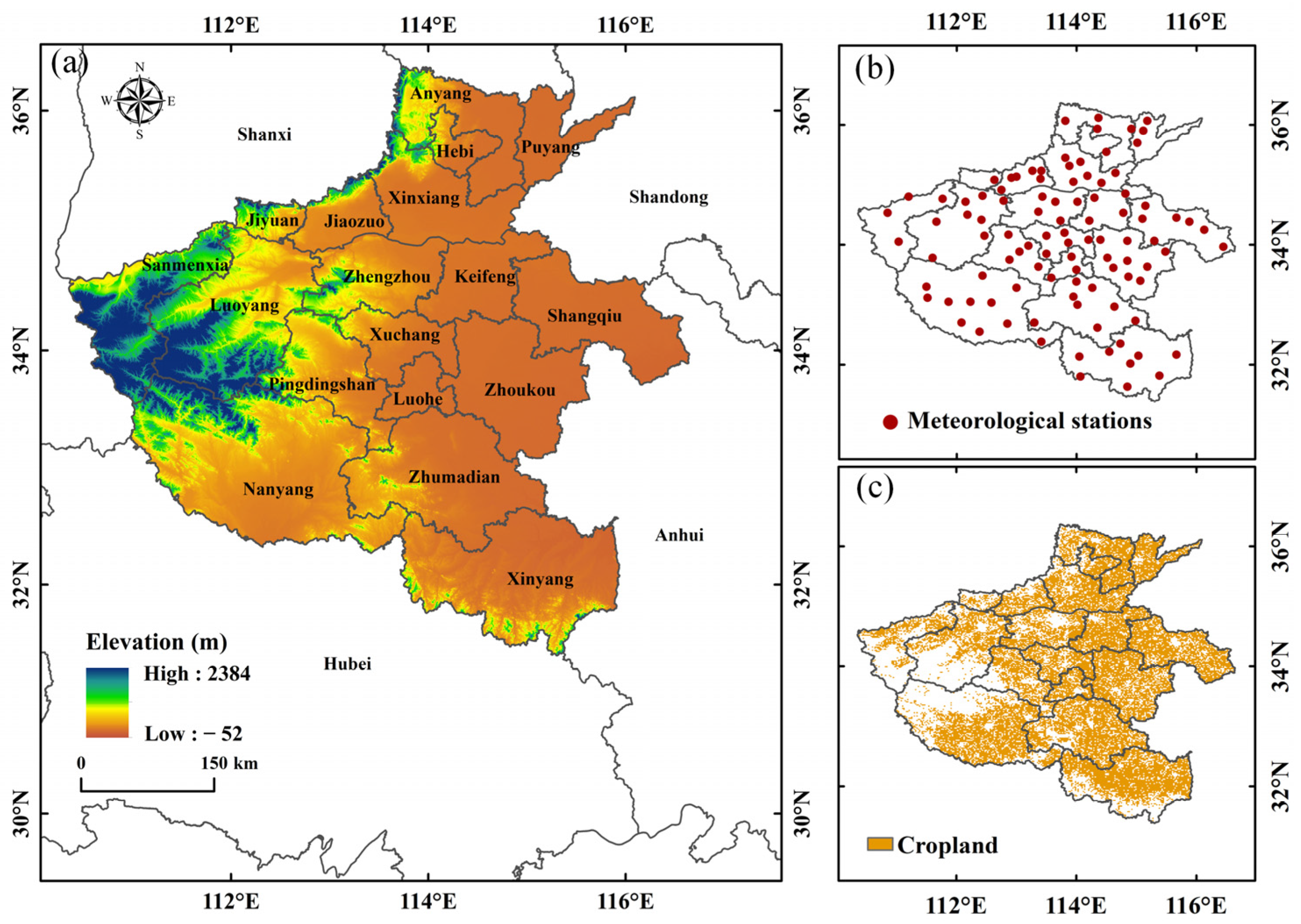
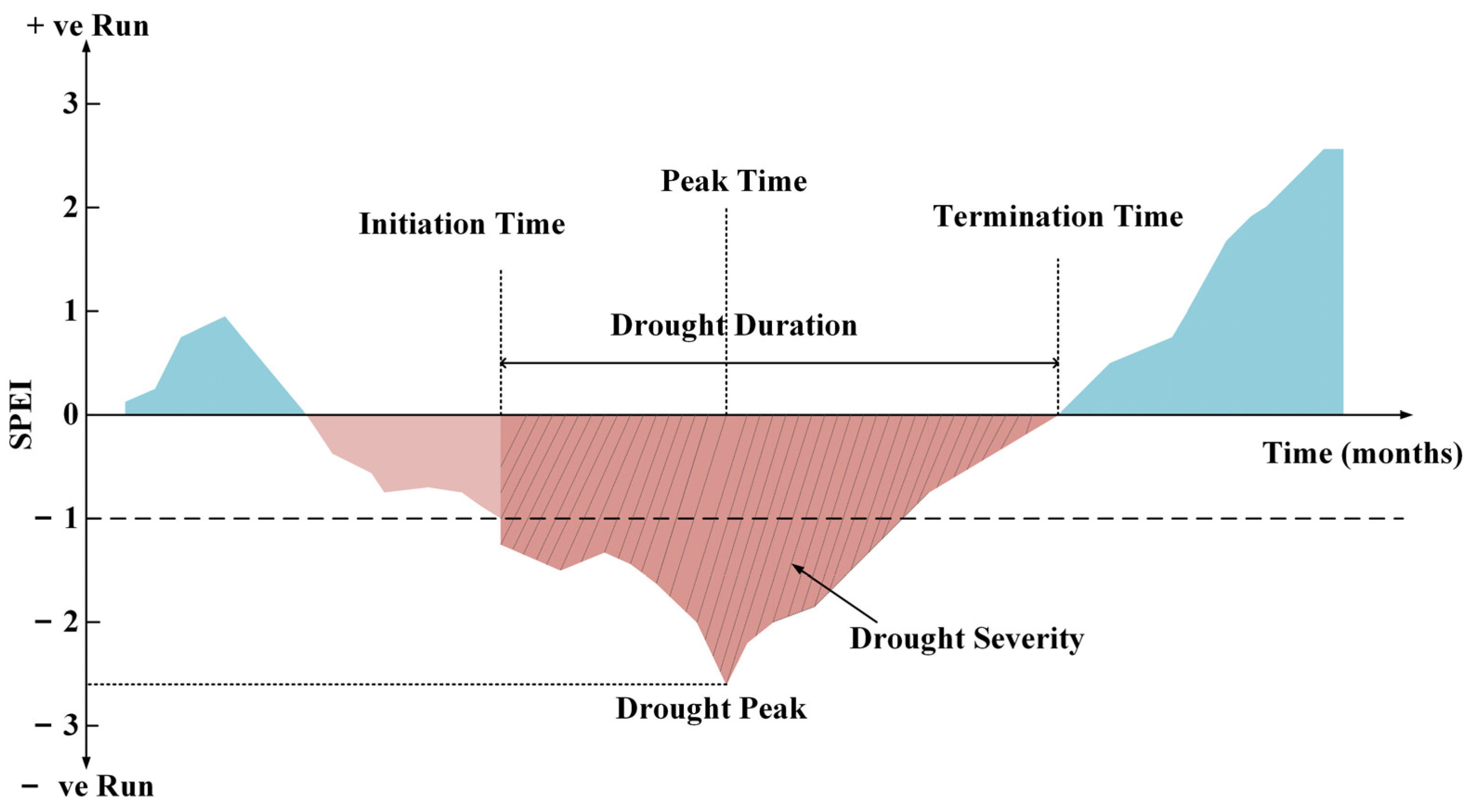

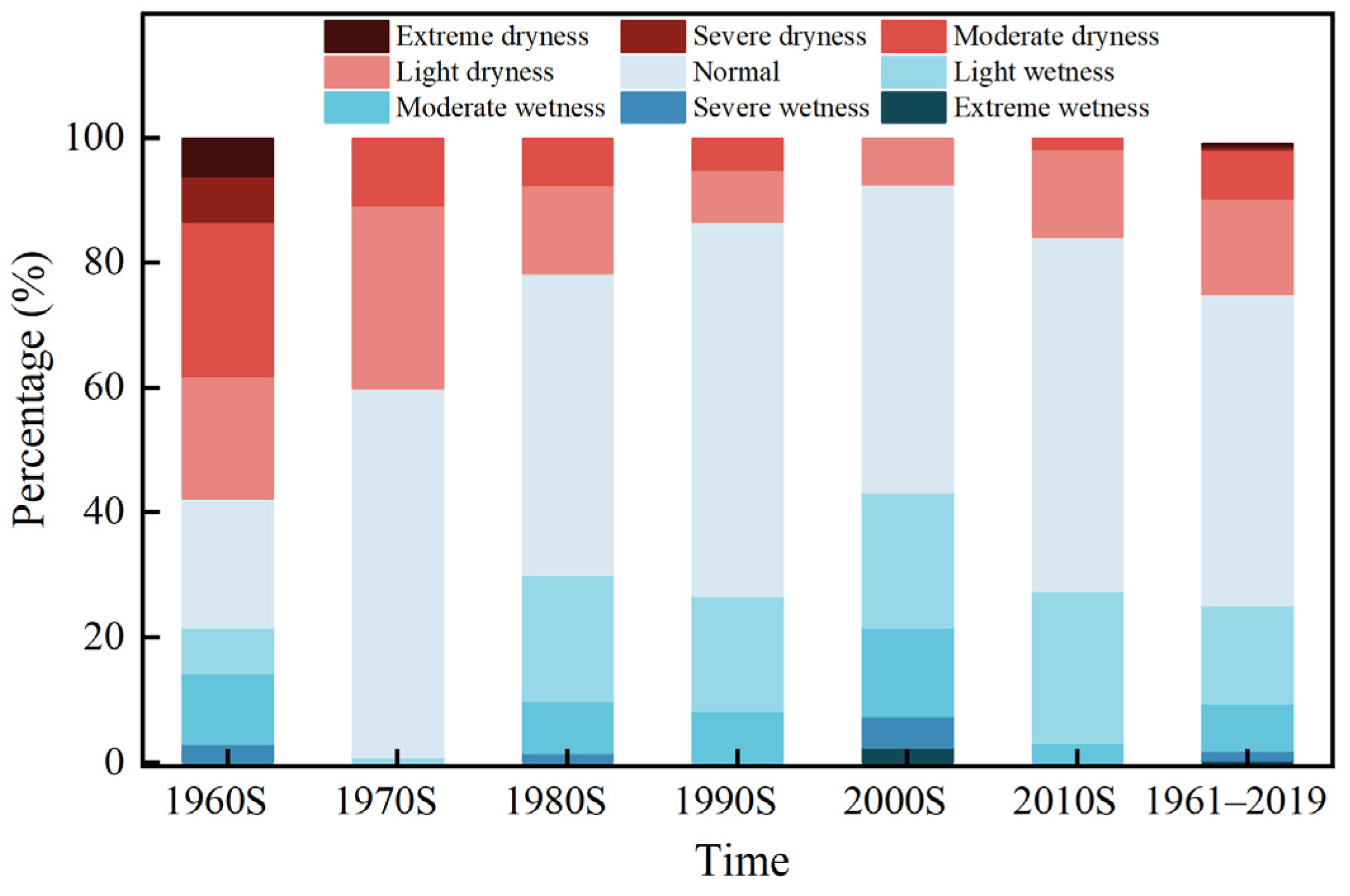
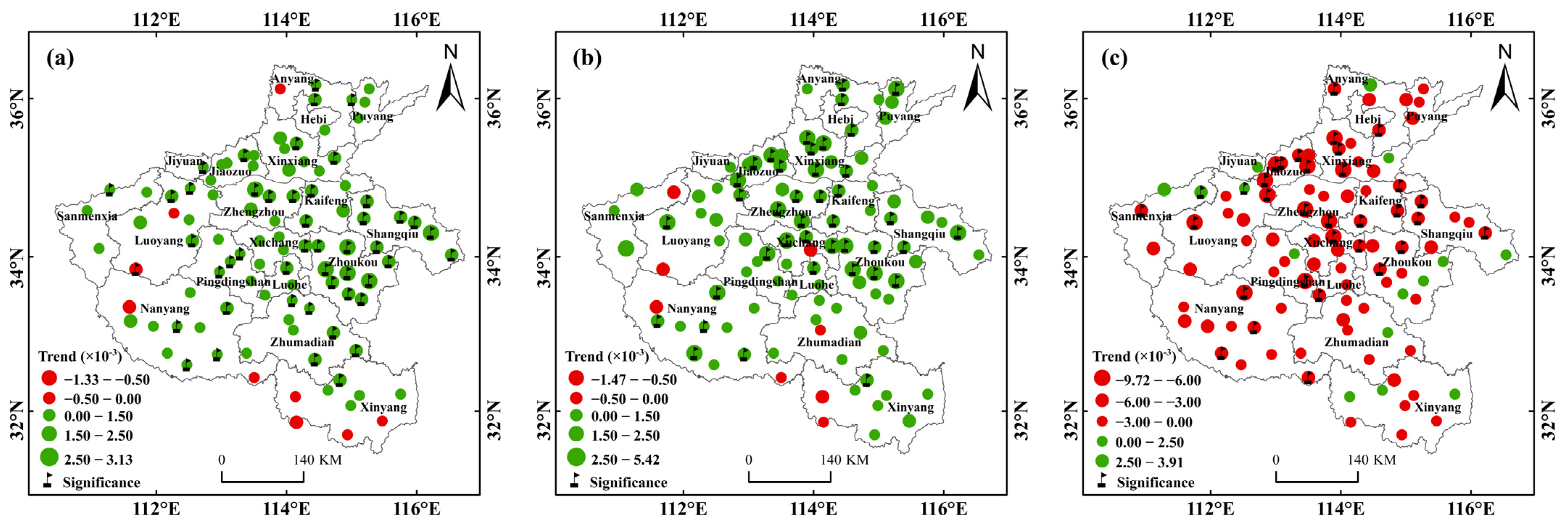
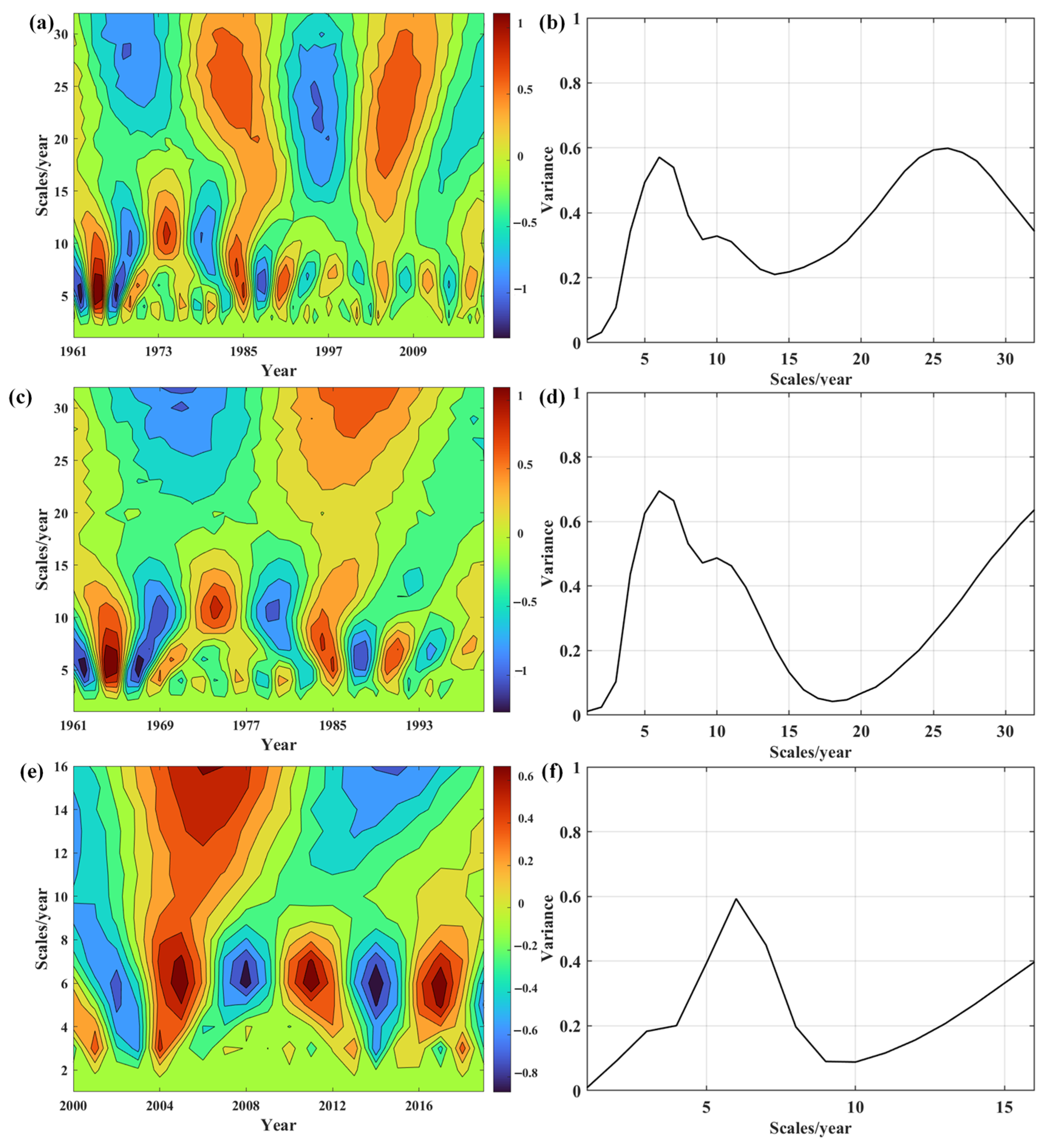


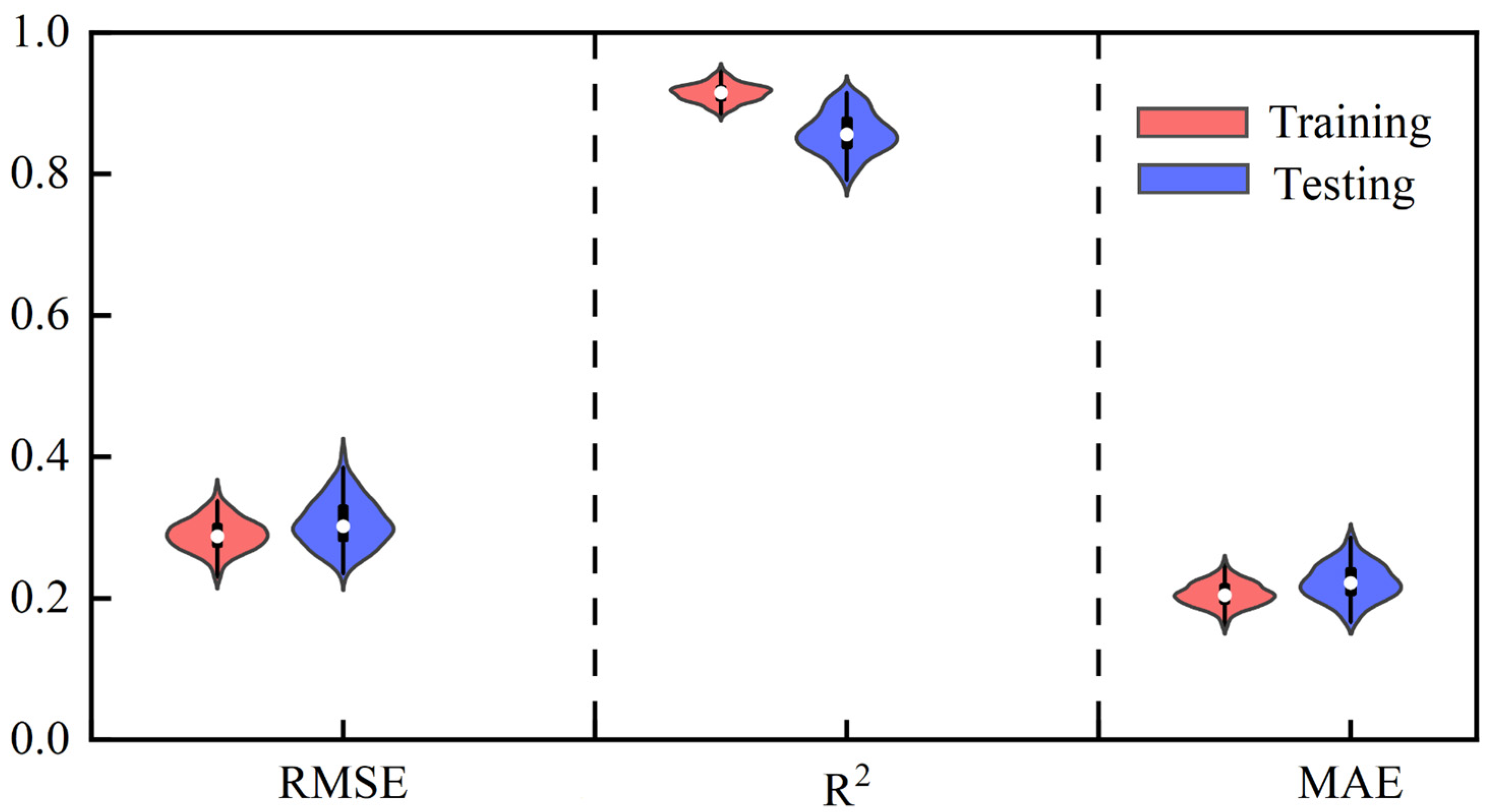
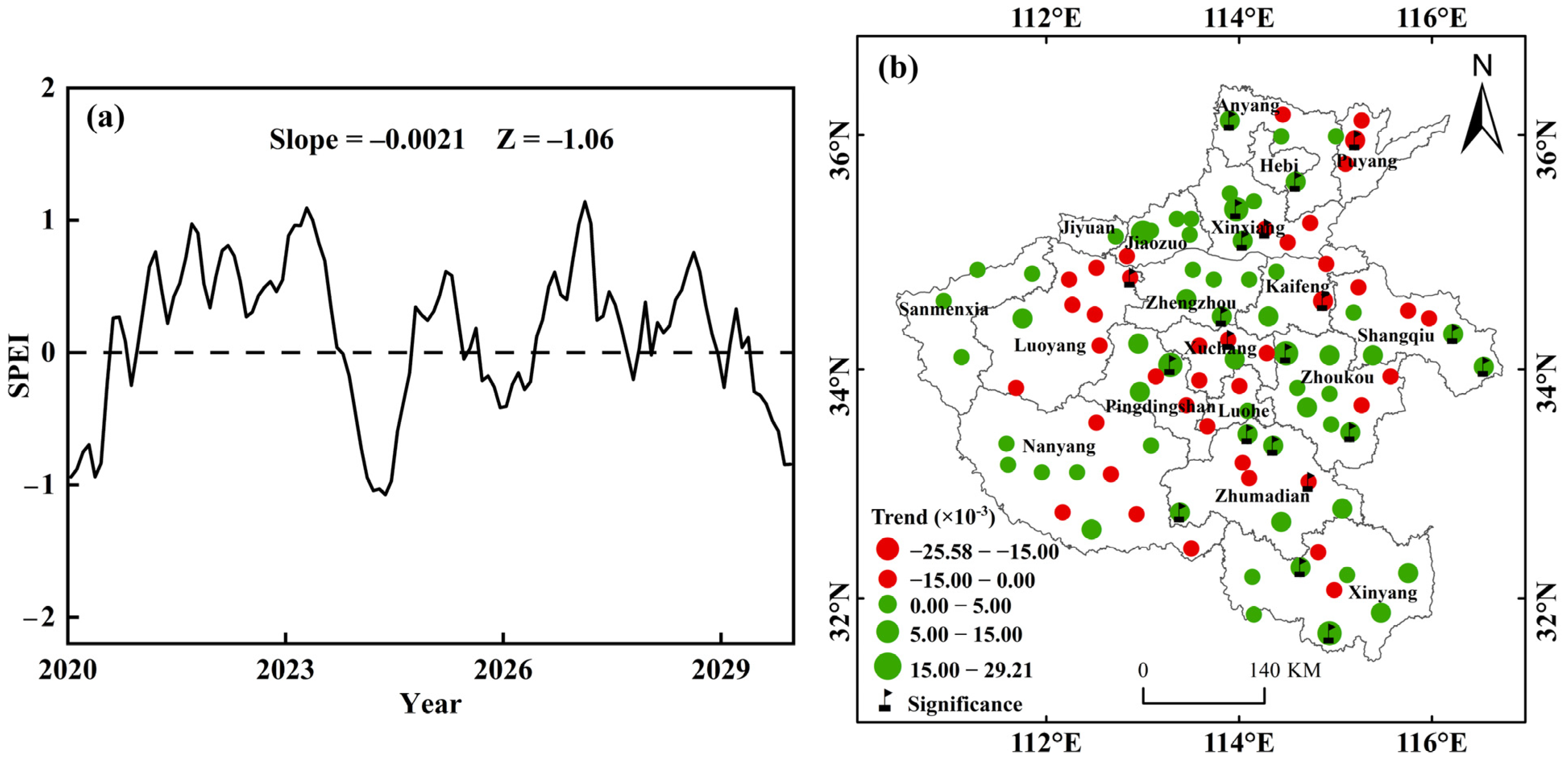

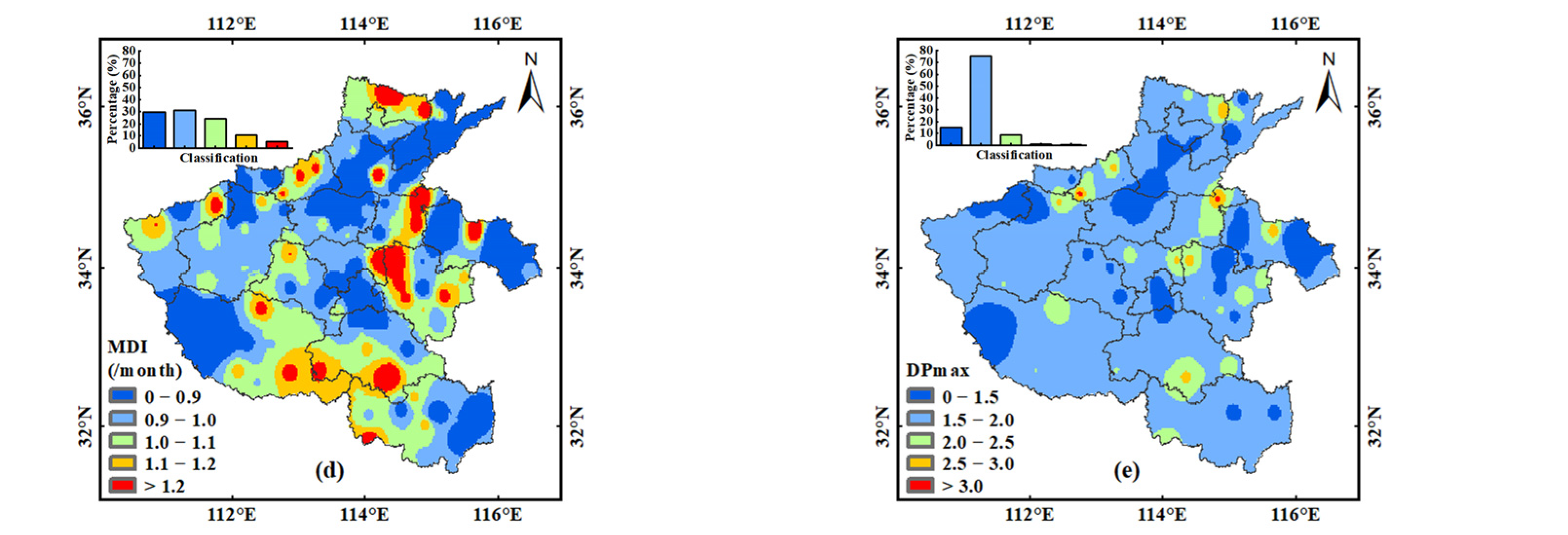

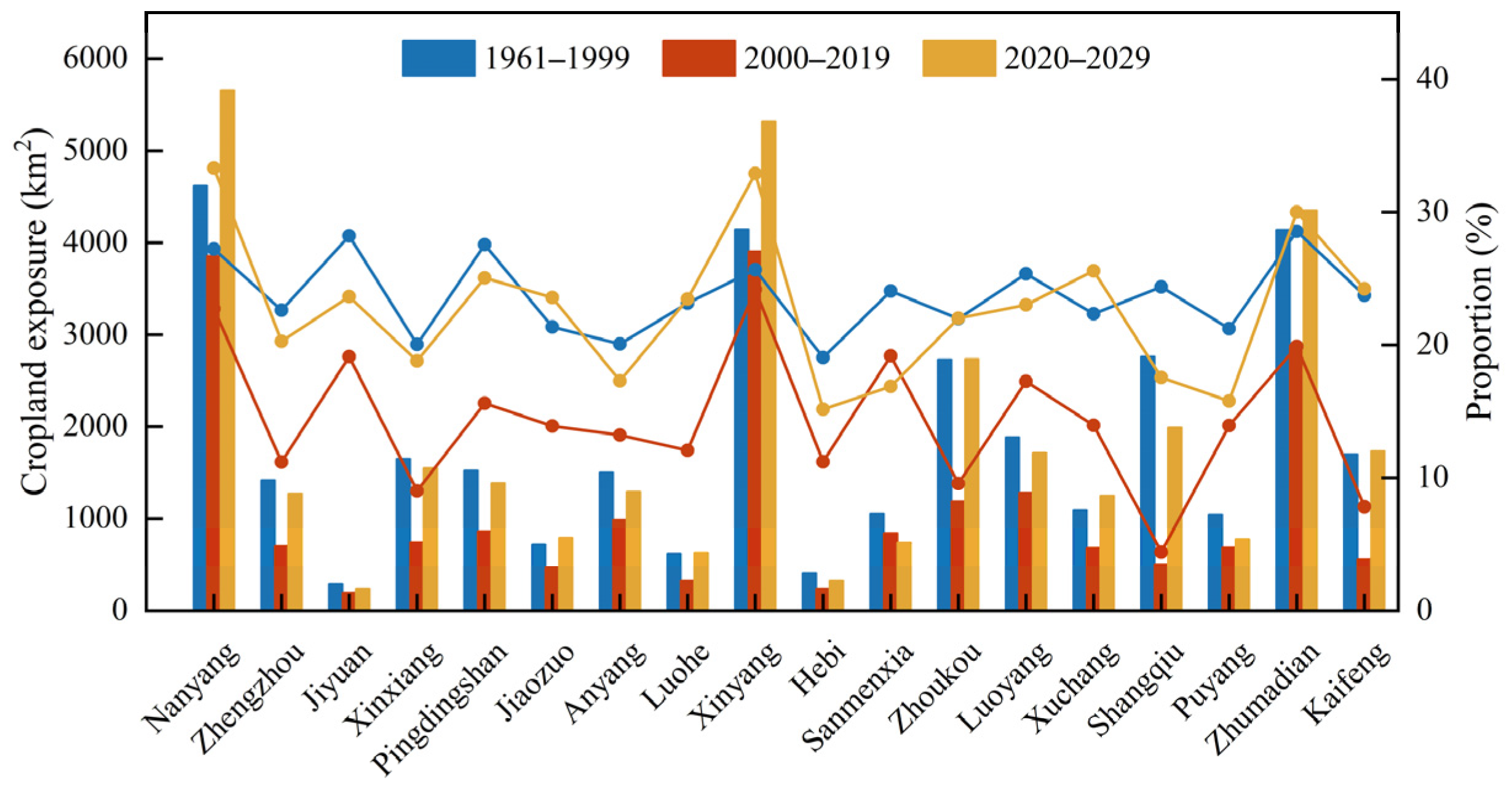
| Region | Event | Initiation Time | Peak Time | Termination Time | DD (Months) | DS | DI | DP |
|---|---|---|---|---|---|---|---|---|
| Henan | D1 | Oct-1965 | Nov-1966 | Oct-1967 | 25 | 40.31 | 1.61 | 2.24 |
| D2 | Jul-1968 | Apr-1970 | May-1971 | 35 | 26.42 | 0.75 | 1.24 | |
| D3 | Dec-1961 | Jun-1962 | Apr-1963 | 17 | 16.85 | 0.99 | 1.43 | |
| D4 | Jul-1978 | Oct-1978 | Aug-1979 | 14 | 16.18 | 1.16 | 1.47 | |
| D5 | Jun-1981 | Oct-1981 | Jul-1982 | 14 | 12.65 | 0.90 | 1.16 | |
| D6 | Oct-1986 | Oct-1986 | Jul-1987 | 10 | 7.46 | 0.75 | 1.15 | |
| D7 | Oct-1997 | Nov-1997 | May-1998 | 8 | 7.24 | 0.91 | 1.19 | |
| D8 | Jul-1974 | Jul-1974 | Jun-1975 | 12 | 6.24 | 0.52 | 1.41 | |
| D9 | Sep-2019 | Sep-2019 | Dec-2019 | 4 | 3.57 | 0.89 | 1.09 | |
| D10 | Aug-1999 | Aug-1999 | Jan-2000 | 6 | 3.09 | 0.52 | 1.18 |
Disclaimer/Publisher’s Note: The statements, opinions and data contained in all publications are solely those of the individual author(s) and contributor(s) and not of MDPI and/or the editor(s). MDPI and/or the editor(s) disclaim responsibility for any injury to people or property resulting from any ideas, methods, instructions or products referred to in the content. |
© 2023 by the authors. Licensee MDPI, Basel, Switzerland. This article is an open access article distributed under the terms and conditions of the Creative Commons Attribution (CC BY) license (https://creativecommons.org/licenses/by/4.0/).
Share and Cite
Guo, L.; Luo, Y.; Li, Y.; Wang, T.; Gao, J.; Zhang, H.; Zou, Y.; Wu, S. Spatiotemporal Changes and the Prediction of Drought Characteristics in a Major Grain-Producing Area of China. Sustainability 2023, 15, 15737. https://doi.org/10.3390/su152215737
Guo L, Luo Y, Li Y, Wang T, Gao J, Zhang H, Zou Y, Wu S. Spatiotemporal Changes and the Prediction of Drought Characteristics in a Major Grain-Producing Area of China. Sustainability. 2023; 15(22):15737. https://doi.org/10.3390/su152215737
Chicago/Turabian StyleGuo, Linghui, Yuanyuan Luo, Yao Li, Tianping Wang, Jiangbo Gao, Hebing Zhang, Youfeng Zou, and Shaohong Wu. 2023. "Spatiotemporal Changes and the Prediction of Drought Characteristics in a Major Grain-Producing Area of China" Sustainability 15, no. 22: 15737. https://doi.org/10.3390/su152215737
APA StyleGuo, L., Luo, Y., Li, Y., Wang, T., Gao, J., Zhang, H., Zou, Y., & Wu, S. (2023). Spatiotemporal Changes and the Prediction of Drought Characteristics in a Major Grain-Producing Area of China. Sustainability, 15(22), 15737. https://doi.org/10.3390/su152215737










